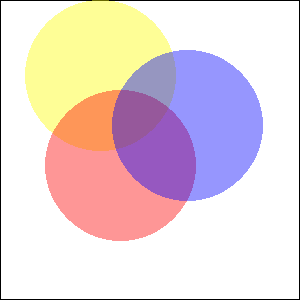When working with transparency, avoid imagecreate() and use imagecreatetruecolor() instead. Transparency effects may not work as expected within a palette-based image.
imagecolorallocatealpha
(PHP 4 >= 4.3.2, PHP 5, PHP 7, PHP 8)
imagecolorallocatealpha — 为一幅图像分配颜色 + alpha
说明
imagecolorallocatealpha
( resource
$image
, int $red
, int $green
, int $blue
, int $alpha
) : int
imagecolorallocatealpha() 的行为和
imagecolorallocate() 相同,但多了一个额外的透明度参数
alpha,其值从
0 到 127。0
表示完全不透明,127 表示完全透明。
如果分配失败则返回 false。
Example #1 使用 imagecolorallocatealpha() 的例子
<?php
$size = 300;
$image=imagecreatetruecolor($size, $size);
// 用白色背景加黑色边框画个方框
$back = imagecolorallocate($image, 255, 255, 255);
$border = imagecolorallocate($image, 0, 0, 0);
imagefilledrectangle($image, 0, 0, $size - 1, $size - 1, $back);
imagerectangle($image, 0, 0, $size - 1, $size - 1, $border);
$yellow_x = 100;
$yellow_y = 75;
$red_x = 120;
$red_y = 165;
$blue_x = 187;
$blue_y = 125;
$radius = 150;
// 用 alpha 值分配一些颜色
$yellow = imagecolorallocatealpha($image, 255, 255, 0, 75);
$red = imagecolorallocatealpha($image, 255, 0, 0, 75);
$blue = imagecolorallocatealpha($image, 0, 0, 255, 75);
// 画三个交迭的圆
imagefilledellipse($image, $yellow_x, $yellow_y, $radius, $radius, $yellow);
imagefilledellipse($image, $red_x, $red_y, $radius, $radius, $red);
imagefilledellipse($image, $blue_x, $blue_y, $radius, $radius, $blue);
// 不要忘记输出正确的 header!
header('Content-type: image/png');
// 最后输出结果
imagepng($image);
imagedestroy($image);
?>
参数
-
image -
由图象创建函数(例如imagecreatetruecolor())返回的图象资源。
-
red -
红色成分的值。
-
green -
绿色成分的值。
-
blue -
蓝色成分的值。
-
alpha -
A value between
0and127.0indicates completely opaque while127indicates completely transparent.
返回值
A color identifier or false if the allocation failed.
更新日志
| 版本 | 说明 |
|---|---|
| Prior to 5.1.3 | Returns -1 if the allocation failed. |
范例
Example #2 Example of using imagecolorallocatealpha()
<?php
$size = 300;
$image=imagecreatetruecolor($size, $size);
// something to get a white background with black border
$back = imagecolorallocate($image, 255, 255, 255);
$border = imagecolorallocate($image, 0, 0, 0);
imagefilledrectangle($image, 0, 0, $size - 1, $size - 1, $back);
imagerectangle($image, 0, 0, $size - 1, $size - 1, $border);
$yellow_x = 100;
$yellow_y = 75;
$red_x = 120;
$red_y = 165;
$blue_x = 187;
$blue_y = 125;
$radius = 150;
// allocate colors with alpha values
$yellow = imagecolorallocatealpha($image, 255, 255, 0, 75);
$red = imagecolorallocatealpha($image, 255, 0, 0, 75);
$blue = imagecolorallocatealpha($image, 0, 0, 255, 75);
// drawing 3 overlapped circle
imagefilledellipse($image, $yellow_x, $yellow_y, $radius, $radius, $yellow);
imagefilledellipse($image, $red_x, $red_y, $radius, $radius, $red);
imagefilledellipse($image, $blue_x, $blue_y, $radius, $radius, $blue);
// don't forget to output a correct header!
header('Content-Type: image/png');
// and finally, output the result
imagepng($image);
imagedestroy($image);
?>
以上例程的输出类似于:

注释
User Contributed Notes
Brett G
22-Sep-2015 10:30
fjoggen at gmail dot com
29-Nov-2007 07:19
If you need to calculate the integer representation of a color with an alpha channel, without initialising an image and using the imagecolorallocatealpha function. Then this function might be of some help:
<?php
function alphaColor($hexColor,$alpha)
{
return bindec(decbin($alpha).decbin(hexdec($hexColor));
}
echo alphaColor("FFFFFF",127);
?>
eric (at) junioronline.us
25-Jan-2006 01:41
If you only wish to extract the alpha value for a color, you can simply extract it like so:
<?php
$color = imagecolorat($im, 50, 50);
$alpha = $color >> 24;
?>
It actually shifts off the first 24 bits (where 8x3 are used for each color), and returns the remaining 7 allocated bits (commonly used for alpha)